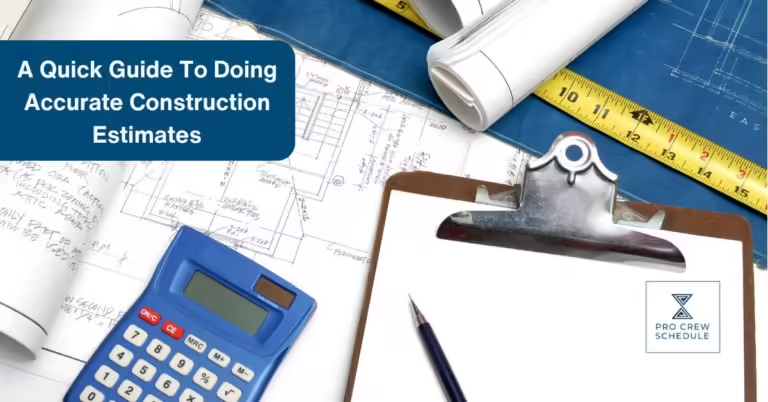When it comes to managing construction projects, it can take a lot of time to understand. From securing inventory and resources to making plans, obtaining permits, renting tools, paying your crew, and staying on top of things, one can easily get lost and get overwhelmed with the number of things you need to do and monitor. These things take time and cost money. As a result, it is critical to have accurate building estimates to get all of the costs and be able to prepare and allocate resources efficiently and effectively.
You have to figure out all the costs of a building job, including direct costs like materials and wages and indirect costs like equipment wear and tear and office worker salaries. This is where accurate construction estimating comes into play. Professional construction estimators perform this critical step in the preconstruction process to help ensure that owners and contractors can finish a construction project successfully, on time, and within budget. Being able to make a reasonable construction estimate and knowing how to make one can mean the difference between getting a lot of new construction business and having a slow downtime.
However, this is easier said than done. To correctly estimate a project’s cost, you need to familiarize yourself with a lot of information and knowledge about building materials, specifications, techniques, building codes, and price trends. In this article, let us go over all the steps you need to take to learn construction estimates, from reviewing a bid package to considering profit and possible problems.
What Are Construction Estimates?
A construction estimate tells you how much it will cost to build the structure you want to develop. It is one of the first and most essential steps in managing a construction job.
A reasonable construction estimate starts with the bid estimation part of a project. An accurate forecast is made using all construction-related paperwork, past data, and other known prices. The profitability of the project depends on the accuracy of the construction estimate, making it essential for any construction business to stay in business.
What Does Construction Estimating Mean?
Finding out how much a building project will cost is called construction estimating. The costs include direct costs, indirect costs, overhead costs, and the general contractor’s earning margin. The goal of construction estimating is to make a construction estimate, which is what general contractors use to bid on building jobs.
When to Use Construction Estimates?
A construction estimate is usually beneficial at the beginning of a job. When the project is just an idea, it can be roughed out with the help of the project manager’s experience and understanding of how much similar projects cost. This is where you will have an idea of what your project will cost and what you can do to lower it. Then, as the building’s planning goes on, more accurate estimates can be made as information about resources, schedules, and other things is gathered.
Since the construction industry is highly volatile, plans will change a little bit during a job. If you find that schedule or other delays will add to the budget, you may have to change some costs. It is critical to add a few contingencies to ensure you account for all the unforeseen costs.
Why Accurate Construction Estimates Are Critical
As mentioned earlier, doing estimates correctly can make or break your project and your organization’s success. Both owners and workers use cost estimates to move a project from the planning stage to the finishing stage and ensure that it is completed with the best value possible.
Once owners have an idea of how much a job will cost, they can decide if it can be done within their budget. After a rough estimate, changes may need to be made to the plan or the project’s scope in order to change the costs.
Accurate figures are also important for contractors to make competitive and profitable bids. A contractor who does not think a project will cost as much as it actually does might have to cut its profit margin to pay for the project.
But if a contractor thinks the job will cost more than it actually does, they might submit a bid that needs to be lowered to be chosen. Building estimates need to be correct even when bids are negotiated to find a good balance between the owner’s budget and the contractor’s profit.
Steps to Accurately Estimate and Forecast Construction Estimates
Estimators in the construction industry usually try to find the best price for a specific job as part of a bidding process that is either open to all bidders or negotiated.
In general, construction estimators follow a process that starts with reviewing bid documents, which can include construction specs and contract documents. The process then provides steps to account for all known costs, such as materials, labor, insurance, and overhead. When the estimator is done, they will have made a building estimate that includes all the costs plus a markup for profit and possible extra costs.
In this section, let us look at the steps to create accurate construction estimates.
Finalize Your Work Breakdown Structures
The first step in estimating the cost of construction is to make a list of all the tasks that need to be done to finish the job. One way to do this is to use a work breakdown framework to break down the scope of your project.
Create A Work Outline
Once you have a good idea of the work that needs to be done, the next step is to create a work outline. This critical building document sets up an agreement between the stakeholders, the contractors, and the subcontractors who will work on the project.
Find Out What Resources Are Needed
After you have outlined the tasks you need to complete, you can figure out how much time, money, materials, tools, and gear you will need for each one.
Create A Bill of Quantities
The building documents, architectural drawings, and computer-aided designs (CAD) are used to make a material takeoff, which is a detailed list of all the materials and quantities needed to build a project.
Based on the results of your material takeoff, you can make a bill of quantities. This document lists all the materials needed for a project and the work required to put them together. You can use it to bid on jobs as a contractor, subcontractor, or site manager.
Look Over the Bid Package
The bid package should include the owner-contractor agreements, bond forms, general conditions, supplementary general conditions, and building specifications needed to bid. When contractors bid on a project, they have to do the work spelled out in the bid package. Because of this, a professional estimate takes a lot of time to make sure they understand every part of the project.
Conduct A Site Visit
In some situations, you need to visit the site before you can make a bid. Most of the time, though, estimators should go to the planned construction site themselves instead of just looking at elevation drawings or photos.
Ask Suppliers and Sellers for Current Prices
Once specialty builders have a complete list of the materials and tools they need, they can start negotiating prices with suppliers and vendors.
Create Timelines and Schedules
Estimators can also use information from the takeoff to estimate the amount of work needed on a job. A specialty contractor’s crew typically consists of tradespeople, laborers, and helpers. General contractors, project-specific managers, or other workers whose work is directly related to a single project and is counted as a cost may also be present.
Consider Insurance and Bonds
Both owners and workers are less likely to lose money when they use insurance and bonds, but this benefit comes at a cost that needs to be factored into project estimates. Almost all construction companies need general liability insurance.
Take Into Account Both Profit and Risk
After adding up all the costs of a building job, the estimator will change the total to include both a profit margin and a contingency plan. The contractor gets a fee for the job, which is the profit. This money can be used to grow the business even more.
Contingency, on the other hand, is a part of the agreement that is set aside for waste and cost overruns, which are customary in building projects.
Essential Parts of a Construction Cost Estimate
Most of the time, the project estimator makes building estimates. It depends on the size of the job and the kind of people who work for the company, but the person making the construction estimate will look at the building plan and many other building papers to figure out how much the whole project will cost. In this section, let us look at the three essential parts of a construction cost estimate.
Costs
There are two times of costs – direct and indirect costs.
Direct costs include things like materials, labor, and tools that are used in the building process.
Indirect costs include quality control, security, energy, office work, legal fees, permits, and other expenses that are not directly related to the building.
Labor Hours
The amount you pay your employees includes a base fee and an estimate of the cost of each job. Taxes and possible overtime should be added.
Costs of Subcontractors
Calculate the price of the work that will be given to subcontractors, including the cost of labor, materials, and tools.
Best Practices for Estimating Construction Costs
Getting a reasonable building estimate is a big part of making sure your project goes well. Even though you can’t always get your money predictions right, there are things you can do to improve them.
Know What Your Customer Wants
When estimating building costs, the first step is to ensure that you and the customer agree on what you want to do.
For that reason, you need to get their approval on the construction plan and make sure they understand what it is and how the construction part will end.
Use The Unit Cost Method
You can do your building estimate in a lot of different ways. In stick figures, you list all the costs of the job, such as the materials, labor, and permits. One method for estimating building costs that takes less time and is just as accurate is the unit cost method. That way, it makes a list of all the things you need for the job, gives each one a price, and then adds them all up.
Get Help from Experts
Another thing you can do is look for people who know more about the building than you do. You probably know a lot about some parts of the building and can give very accurate cost estimates for those parts, but you might need to learn more about other parts of the building project. Feel free to ask for help.







